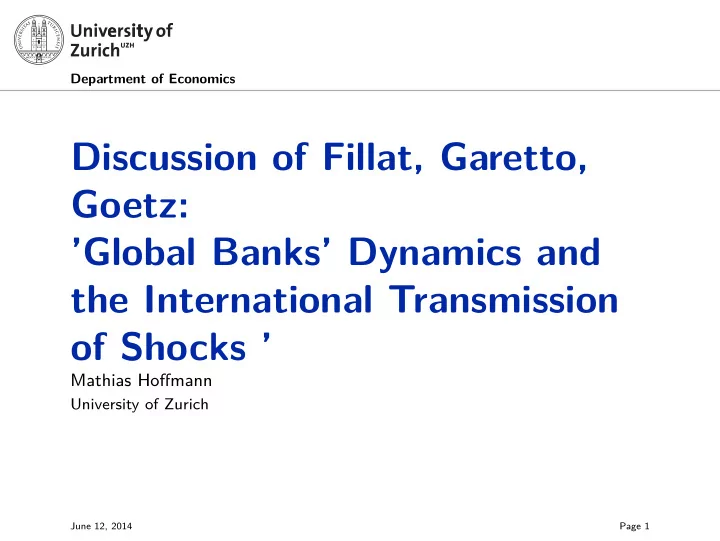

Department of Economics Discussion of Fillat, Garetto, Goetz: ’Global Banks’ Dynamics and the International Transmission of Shocks ’ Mathias Hoffmann University of Zurich June 12, 2014 Page 1
Department of Economics What they do – Document an interesting set of stylized facts on foreign banks in the US – Develop a compact theoretical model that can explain the mode of entry of foreign banks and replicates salient features of their balance sheets. – Model is then used to study international transmission. June 12, 2014 Page 2
Department of Economics Stylized facts – Foreign banks in the US are big: – subsidiaries are bigger than branches – but irrespective of mode of entry, they are much bigger than the average domestic bank – Parents of US foreign banks are big in their home countries. – The portfolio structure of subsidiaries is closer to that of domestic commercial banks (high share of loans), that of branches much closer to that of investment banks (fewer real estate loans, more C&I and other stuff) – Branches are net creditors towards their parents over most of the sample period. June 12, 2014 Page 3
Department of Economics The model – Monopolistic competition in the loan market at home and abroad. – Fixed cost F S ( F B ) of establishing a subsidiary (branch), with F S > F B . – Parents (P) and subsidiaries (S) accept insured deposits and are separately capitalized – Branches (B) accept only non-insured deposits, are fully consolidated into the parent, have no equity. – P can borrow in the home money market, B and S in the host country (US) money market. June 12, 2014 Page 4
Department of Economics Preview of comments – What stylized facts to focus on? – Setup of the model: some questions – State-level banking deregulation in the US: a training ground for the model? June 12, 2014 Page 5
Department of Economics Comment I: stylized facts – FGG show that big banks internationalize. But model also predicts that bigger banks are more likely to go for subsidiaries. No direct evidence of this in your stylized facts — > Buch, Koch, Koetter (JIE 2011, JBF 2014)! – Granularity in bank size distributions matters for international transmission. – how much of the granularity of the US bank size distribution is due to foreign banks? – Impact of deregulation history on US bank size distribution: interstate-banking deregulation allowed for cross-state ownership of subsidiaries, not of branches! How do things look for other countries? June 12, 2014 Page 6
Department of Economics Comment II: model setup Consider the bank’s problem L , D , I , M { pr ( L ) L − ( 1 − p ) L + r I I − r D D − r M M − aC ( D , L , I ) − f p D } max s.t. the constraints M + D + E = L + I E ≧ k ω L L + ω I I June 12, 2014 Page 7
Department of Economics Comment II: model setup (cont’d) – The FOC ( 1 − p ) + a ∂ C p [ r ′ ( L ) L − r ( L )] = ∂ L + r M ( 1 − k ω L ) r D + a ∂ C = ∂ D + f p r M a ∂ C r I = ∂ I + r M ( 1 − k ω I ) generates corner solutions in the current setup. Ensure interior solutions e.g. by penalizing wholesale funding with a risk premium or the riskyness of investment. Or by fixing the cost function: currently, it is linear in L , I , quadratic in D . June 12, 2014 Page 8
Department of Economics Comment II: model setup (cont’d) – As it stands, the problem of founding a subsidiary does not affect the problem of the parent bank in its home market. This is because the foreign subsidiary pays for the entry cost from its own funds and raises capital on the market. But that’s not what a subsidiary is: entrepreneurial control by the parent entails the parent has to raise E ∗ and pay F S from these funds. June 12, 2014 Page 9
Department of Economics Comment III: state-level deregulation – The sequencing of state-level banking deregulation in the US seems like a natural laboratory to test the predictions of the model. – Interstate deregulation till 1995 allowed to formation of big MBHCs that effectively owned several subsidiaries. From the mid-1990s, interstate branching restrictions were also dismantled, further lowering the cost of entry. Two implications: – This pattern should affect the size distirbution of banks in the US sample. – It should also give strong predictions for the types of banks that can enter after each wave of deregulations. June 12, 2014 Page 10
Department of Economics Summing up – Great and promising project. – But still incomplete. More work needed. June 12, 2014 Page 11
Recommend
More recommend